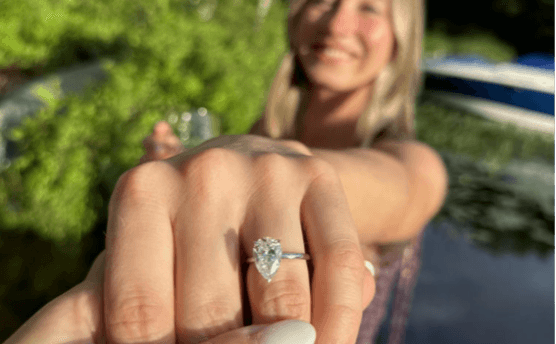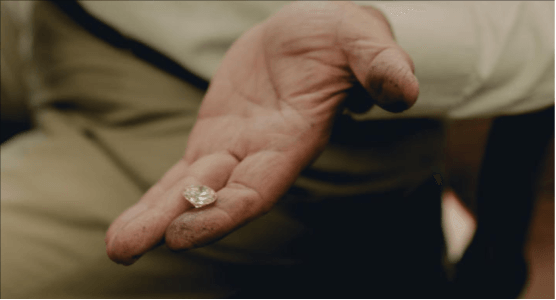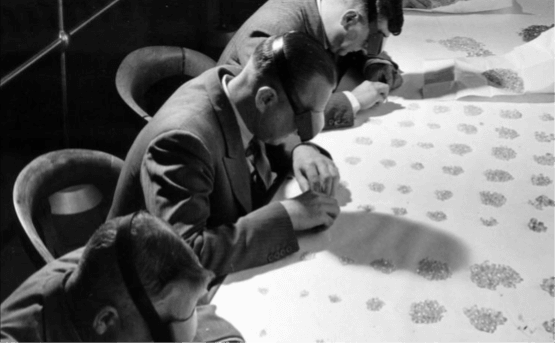De Beers chief executive Al Cook wants to save a generation of lovers and newlyweds from what he calls a “huge con” when it comes to buying diamonds.
In the process, he hopes to rescue his iconic brand—and perhaps the diamond industry as it has existed for more than a century—from an ominous decline.
London-based De Beers almost single-handedly persuaded generations of consumers that love wasn’t genuine unless it was sealed with a diamond. The stones were prized not only for their beauty but also as a miracle of nature formed over a billion years deep in the earth, and then extracted in exotic locales—often on behalf of De Beers.
Now diamonds can be made in labs that mimic the earth’s extreme pressure and temperatures, but for a fraction of the price. A decade ago, such man-made gems were novel. Today they are mainstream, and increasingly challenging the perception of diamonds as a luxury accessory.
Walmart sold its first lab-grown diamonds in 2022, but now the stones make up half of its diamond jewelry assortment.
Signet Jewelers, which says it is the world’s largest retailer of diamond jewelry, with brands that include Kay Jewelers, Zales and Jared, is partnering with De Beers to extol the virtues of natural diamonds in a new marketing campaign. But last month, Signet said it, too, has been adding more lab-grown diamonds to its fashion jewelry, which was among the factors helping to pull the company out of a prolonged sales slump.
Synthetic diamonds currently account for more than a fifth of global diamond jewelry sales, up from less than 1% in 2016, according to Paul Zimnisky, an independent analyst.
For engagement rings, the penetration is even higher. More than half the engagement rings purchased last year in the U.S. had a lab-created diamond, a 40% increase compared with 2019, according to a survey of nearly 17,000 U.S. couples by wedding planning website The Knot.
“Diamonds were always seen as expensive, a rich person’s asset,” says Matt Bick, a third-generation diamond seller with a showroom on the same London block as the De Beers headquarters. “Now everyone can wear them.”
And that is Cook’s quandary.
A geologist and former longtime oil and gas executive, Cook took the helm of the diamond-mining and jewelry giant in early 2023. Since then, the influx of lab-grown diamonds out of China, India and elsewhere has turned into a flood, crushing demand for natural stones.
Over the past two years, De Beers’s parent, mining giant Anglo American, has slashed the book value of its majority holding in the diamond unit by about 45%, or $4.5 billion.
Last year, while fending off a takeover attempt, Anglo said it would spin off De Beers through a sale or listing to focus on businesses like mining copper and iron ore, but for months found a dearth of potential buyers at prices it can stomach. That has led to preparations for Plan B, a public listing.
Anglo executives hoped to be well into the process of hiving off De Beers by now, but increasingly it looks like any deal could take until next year, Cook and others say.
With Trump’s tariffs sparking fears about an all-out trade war, De Beers may need a Plan C. The U.S. is the world’s largest diamond-jewelry consumer, with no commercial mines of its own. Threatened tariffs have already made cut and polished natural diamonds more expensive in the U.S., at a time when many consumers are already choosing the more affordable lab-grown variety
De Beers and Anglo have recently signed nondisclosure agreements with around a dozen suitors for the diamond business, people close to the companies say. An IPO is not off the table, and Anglo executives have said privately that the company won’t rush a sale if they think waiting will get them a much better deal.
Cook says he knew taking the De Beers job would almost certainly mean helping sell the company. He didn’t know Anglo would be pressured to move so quickly.
Going all in
In one of his first big moves, Cook shuttered De Beers’s production of its own lab-grown diamond jewelry under the brand name Lightbox. Cook’s move effectively put De Beers all-in on a bet that it could reverse the multiyear drag on the prices of mined diamonds.
Manufactured diamonds are 100% carbon, with the same hardness and sparkle of the original. Nevertheless, De Beers’s future depends on consumers who believe that authenticity can’t be made in a lab.
During an interview at the company’s historic headquarters in Central London, Cook said too many mass-produced stones are masquerading as something special to justify steep markups. He argues that shoppers are cheated when similar pieces of lab-grown jewelry are for sale at wildly different prices depending on who’s selling them.
“I’m deeply worried there’s a huge con going on around lab-grown diamonds,” Cook said. “I can’t believe that’s sustainable.”
He added that the democratization of diamonds diminishes what made them special in the first place. “For as long as humans have been conscious,” he said, “we’ve prized something precious and rare.”
To sell a new generation of shoppers on the virtues of natural diamonds, Cook pushed for Anglo to sharply increase De Beers’s marketing budget to its highest in a decade. Together with Botswana, the company’s biggest diamond supplier and a minority owner, they boosted De Beers’s marketing allocation by more than 25% this year.
The effort coincides with a push by organizations such as the Natural Diamond Council to promote mined diamonds while maligning the lab-grown variety.
The nonprofit trade group called lab-grown diamonds “The Dupe” on billboards it tested in Manhattan earlier this year. They referred to mined diamonds as “For Better,” and lab-grown as “For Worse.”
“People think natural and lab-grown diamonds are the same,” said Kristina Buckley Kayel, the Natural Diamond Council’s managing director for North America. “They are not.”
De Beers helps fund the Natural Diamond Council and sits on its board, but isn’t involved in developing its marketing campaigns, a De Beers spokesman said.
The first De Beers ad campaign as part of a partnership with Signet aired in late 2024 and took a higher road. Called “Worth the Wait,” the ads show couples in various stages of courtship, interspersed with images of volcanic eruptions and lava flows. The tagline: “Just like your journey, a natural diamond is worth the wait.”
Cook also earlier this year extended a licensing deal with Botswana to ensure De Beers a steady supply past 2050, ending a nearly six-year stalemate with the African nation that produces the majority of its diamonds.
Both sides dug in as they sized up what’s at stake. Botswana, which depends heavily on diamond exports, has slashed its economic-growth forecasts as it grapples with the protracted industry slump.
Together the partners are trying to drum up demand and fighting to shake the taint of practices that marred the industry’s reputation—the trafficking in so-called blood diamonds mined in war zones, with profits used to fund insurgencies.
“We are where we are because of the value of diamonds,” says Botswana’s ambassador to the U.S., Mpho Mophuting.

When he meets with jewelers and young people, Mophuting talks about how the diamond industry has funded schools, infrastructure like fiber-optic cables and his own graduate education.
The message doesn’t always resonate with price-conscious buyers. Before she got married last year, Samantha Boselli, a 29-year-old publicist from Hooksett, N.H., chose a 3.5-carat, pear-shaped diamond for her engagement ring. It was grown in a lab.
“The size we could get for the price was unbeatable compared to a natural diamond,” Boselli says. She doesn’t care that the stone likely won’t hold its value.
“When I’m 80 and looking to pass it to a daughter or granddaughter, it will still be a sentimental and beautiful diamond,” she says. “It’s not like I’m looking to resell it.”
‘A diamond is forever’
De Beers gets its name from two Dutch-Afrikaner brothers, Diederik Arnoldus de Beer and Johannes Nicolaas de Beer, who settled in South Africa and discovered diamonds on their farm in the late 1800s.
De Beers grew to control some 90% of the world’s diamond trade. When diamond demand collapsed during the Great Depression, De Beers hired the advertising agency N.W. Ayer, which convinced Hollywood actresses to wear diamond rings. One of its copywriters in 1947 came up with the now famous tagline “A Diamond is Forever.”
Over coming decades, De Beers broadly succeeded in dictating how much should be spent on a diamond engagement ring: “Isn’t two months’ salary a small price to pay for something that lasts forever?” asked a 1980s De Beers ad.
By then, however, the company’s influence was waning as new diamond mines in Russia and elsewhere were discovered. In the early 2000s, the controversy over blood diamonds was cresting at the same time independent producers were undercutting De Beers.
Innovation in manufactured diamonds threw up new hurdles. Though General Electric has been producing lab-grown diamonds for industrial use since the 1950s, technology and consumer tastes evolved rapidly in the past decade.
Even gem experts need specialized machinery to tell the difference between quality lab-grown and mined diamonds. De Beers is now trying to draw more attention to the hard-to-see differences, by asking jewelers to shell out $9,500 for a new diamond-testing device called DiamondProof.
The device is about the size of an air fryer and designed to be displayed on jewelry-store counters. It takes just a few seconds to show color-coded results: If the stone’s image glows blue, it’s natural—a result De Beers says it can guarantee. If it glows yellow, it’s lab-grown or needs further testing.
De Beers hopes that if such a simple-looking contraption can so easily tell mined stones from lab-grown, shoppers might be convinced that there really is a meaningful difference between the two.
‘Fashion trends change’
Most luxury jewelers have opted not to sell lab-grown diamonds. “They are not rare or natural,” says Victoria Reynolds, Tiffany & Co.’s chief gemologist. “There is an overabundance of them.”
Sellers that appeal to more price-conscious consumers have less leeway.
Sales of lab-grown diamonds at Walmart, the country’s second-largest fine jewelry seller behind Signet—according to National Jeweler magazine—soared 175% in 2024 compared with the prior year.
“Our customers are looking for that type of value,” said Chris Steinmann, Walmart’s vice president of merchandising, jewelry and accessories.
The Danish retailer Pandora made a decision in 2021 to sell only lab-grown diamonds, partly due to their lower price, but also because it feels they are less harmful to the environment.
Pandora CEO Alexander Lacik said they represent a breakthrough technology that can’t be stopped through negative advertising.
“This happened with the car and horses and carriages,” he said. “The world is changing.”
Signet had been more reluctant to jump on the lab-grown bandwagon than other middle-market jewelers, which some analysts say contributed to a prolonged sales decline, plunging stock price and a large shareholder who had pushed for a sale of the company.
Signet Chief Executive J.K. Symancyk, who took the helm in November, laid out a new strategy in March that includes pushing more heavily into lab-grown diamonds for fashion jewelry like tennis bracelets, earrings and necklaces, while aiming to protect the allure of natural stones for milestone purchases like engagement rings.
Sales of fashion jewelry with lab-grown diamonds increased 60% in the most recent quarter, compared with a year ago, one factor that helped the company’s overall sales return to growth for the first time since April 2022.
He added that nearly two-thirds of Signet’s customers still prefer mined diamonds for special occasions like anniversaries and engagements. “We see natural diamonds as lasting and enduring,” Symancyk says. “Fashion trends change.”
Signet’s 20,000 sales associates were recently required to complete a digital training course that taught them how to better communicate the unique features of natural diamonds to their customers, including their origin story, scarcity and intrinsic value.

“You can’t really create the magic when you’re talking about a stone that was created in a lab,” said Christine Vassar-Raus, a regional vice president for the Signet-owned Jared chain, who demonstrated the selling techniques in a Connecticut store on a recent afternoon. “It’s just not as romantic.”
The influx of lab-grown diamonds has pushed prices down for both types of stones.
The retail price of a 1-carat lab-grown diamond has plunged 86% since the beginning of 2016, to about $745, Zimnisky estimates. The price of the same size natural diamond is down 40% over that period to $3,925. Back in 2016, there was only about a $1,000 difference between a 1-carat lab-grown and natural diamond. A natural diamond now costs about five times as much as man-made stone.
The plunging prices of lab-grown diamonds have led to buyer’s remorse for some consumers.
After buying a pair of lab-grown diamond earrings, Durée Ross has sworn off the synthetic stones. She likened them to wearing a counterfeit handbag, even though lab-grown diamonds aren’t fake.
“I just didn’t feel good about wearing them,” said the 49-year-old communications professional, who lives in Fort Lauderdale, Fla. “Natural diamonds have a better chance of holding their value. They are more of an investment piece.”

Cook, the De Beers boss, describes a future in which abundantly available lab-grown diamonds continue to lose value, pushing them closer in the consumer’s eye to cheaper knockoffs like cubic zirconia and moissanite, which have different chemical structures and are readily identified as imitations.
For those who’ve paid $2,000 for a 1-carat lab-grown diamond only to see its value collapse, Cook offered condolences: “I weep for you.”
